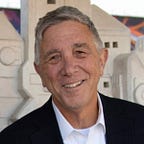Meeting DAN at 3am to get the real news that actually matters
If you don’t know DAN, you should. Here’s why.
You seek to know what’s happening in the world — or at least in your world. The talking heads and screaming headlines created by corporations streaming into your mobile amount to mostly clutter.
At the end of the day, think about the news that truly impacts you. Will rents go up? Will the local businesses you depend on be in business next week? Will your health care provider have the protective gear required? Is the bus service dependable? Can you get a better (or any) job nearby? Does your city hall have a plan out of the economic free fall? Is there one calm cafe that serves a good latte with a place to sit and ponder your future in the most uncertain of times? If you happen to live in Albuquerque, New Mexico, you have a trusted news source in DAN — Downtown Albuquerque News.
As someone who spends his time working in localities to ensure vital services for surviving and thriving (including the collision of the pandemic, economic free fall and social injustice), I see DAN as the model for community news that empowers local residents. There could be great value in a DAN-like enterprise in every city and town.
I set up an interview with Peter Rice, the founder of DAN, to ask how he does it and why local independent news matters now more than ever.
Why did you start DAN?
Peter Rice: I’ve been doing journalism on and off since age 12, so I missed the craft after several years in other industries. Beyond that, this whole self government experiment basically depends on voters having access to good information, and the decline of newspapers in recent years has placed a major stress on the system. I’m hoping the DAN model can spread and counteract that.
Before DAN, where would residents get the news about their local community?
We have three TV stations and a daily paper, so it’s not like local news never happened, but it was really patchy. You can go only so deep when your coverage area is a vast region in America’s fifth largest state. But my zone is five square miles, so our product is way more comprehensive, even if it’s basically useless to people who live on the other side of town.
How did you decide on DAN — geographically speaking?
These things are never perfect, but natural borders help. We’re surrounded by a river, a freeway, and some railroad tracks. But we’re not super strict about it. We’ll certainly mention and occasionally cover stuff outside the zone. It’s more of a guideline than a hard rule.
What does it take to put out one day’s worth of DAN (what is a day like?)
Typical day is maybe three or four hours of writing/production, a couple hours of meetings, and some combination of phone calls and wandering around looking at stuff. Journalism is a pretty low tech affair, even in the digital age.
How do you decide on stories?
The best story is some kind of change we all have in common. This week I worked on a story about illegal pandemic-era drag racing, which is more popular now that there’s less traffic and people have more free time. It’s relevant because we can all hear it happening from our homes at night and we’re all a bit more wigged out by the prospect of walking around. So construction, development, transportation, prominent art projects, history of commonly beloved places, and the like generally make for good stories.
How important is news on city and county elected officials and their voting?
Some papers take their cues on what issues to cover from the politicians, but we’re close enough to the ground that we can write about issues then loop the politicians in when called for. But yes it’s extremely important. We elect them to deal with issues, so their actions are a critical part of the story.
Where do you get data from?
Sometimes it’s on the internet, but we do our own survey work also. (Nothing too crazy. One of our regular monthly features is checking gas prices at eight stations.) Once a month I also check in with about seven people who individually send over numbers on soup kitchen meals, how many people went to the zoo, etc.
Who do you get help from?
Readers mostly. They often send in hot tips and good probing questions that can be the subject of stories in and of themselves.
What do you like most about this project? What do readers like most?
I think we’re all naturally curious about our surroundings, particularly if you’ve made a big emotional or financial investment in an area. So having basic information/intel about a place is both interesting and possibly the basis of important decisions people have to make.
How is this project funded?
Reader subscriptions.
There you have it. A model for local news that can highlight solutions to real local challenges. Check out DAN here (and tell Peter, “Dom sent me.”)
Fight! Survive! Thrive!
Please excuse any typos as I construct an article at 3am on only one cup of Joe. These stories are mine and mine alone. I do not represent any organization here. If one of my illustrations looks like a real human or three-headed hydra, that’s total coincidence. Words and images ©Dominic Cappello but share with everyone you know. Questions? The groundbreaking graphic novel and manifesto Attack of the Three-Headed Hydras awaits you here: www.tenvitalservices.org.
